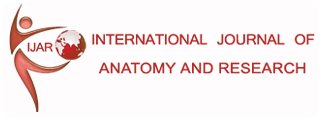IJAR.2017.368
Type of Article: Original Research
Volume 5; Issue 4.1 (October 2017)
Page No.: 4454-4459
DOI: https://dx.doi.org/10.16965/ijar.2017.368
HUMERAL MORPHOMETRICS: A STUDY IN EASTERN INDIAN POPULATION
Moumita Chatterjee 1, Iman Sinha *2, Ratnadeep Poddar 3, Asis Kumar Ghosal 4.
1 Ex PGT, Dept. of Anatomy, Institute of Post-Graduate Medical Education & Research (IPGME&R), Kolkata, India.
*2 Assistant Professor, Dept. of Anatomy, Institute of Post-Graduate Medical Education & Research (IPGME&R), Kolkata, India.
3 Demonstrator, Institute of Post-Graduate Medical Education & Research (IPGME&R), Kolkata, India.
4 Professor cum HOD, Institute of Post-Graduate Medical Education & Research (IPGME&R), Kolkata, India.
Address for Correspondence: Dr. Iman Sinha, Assistant Professor, Dept. of Anatomy, Institute of Post-Graduate Medical Education & Research (IPGME&R), 244 AJC Bose Road, Kolkata 700020, India. E-Mail: isimansinha@gmail.com
Abstract
Background: Estimation of stature from bones plays an important role in identifying unknown dead bodies, parts of bodies or skeletal remains. Anthropometric techniques have been commonly used to estimate stature and bone length from these. Various implants are available for the diverse fracture patterns observed in both ends of humerus, which are contoured on the basis of morphometry of the concerned part. The present study focuses on deteremining the total length, mid shaft girth, breadth of distal and proximal ends, maximum transverse diameter of head, maximum vertical diameter of head, breadth of trochlea and capitulum & comparing these parameters between two sides.
Aims :This study focuses on analysing some important bony features of right & left humerus & compare them.
Materials and Methods: Random collection of 100 dry and processed humerus of both sides, from the skeletal sets of medical students and the Department of Anatomy, IPGME&R, Kolkata were done, by purposive sampling technique. This was a cross-sectional observational study. Dry bones were collected. Un-ossified and diseased bones were excluded from the study. Measurements were taken with the help of osteometric board, electronic digital calliper and measuring tape. Lengths and breadths were measured in millimetres. Data was summarized by routine descriptive statistics. All numerical variables analyzed were normally distributed by Kolmogorov-Smirnoff goodness-of-fit test. Comparison between left and right cohorts was done by Student’s independent samples t test.
Results and Conclusions: Mean total length of the bone was 295.97±19.19mm. Mean value of breadth of proximal & distal ends were 45.53±3.59 mm 56.76±3.69 mm, mid shaft girth 60.28±4.21 mm, maximum transverse & vertical diameter of head were 38.94±2.97 mm & 35.37±3.31mm, breadth of trochlea & capitulum were 22.88±3.20 mm 16.32±1.63 mm. No significant difference was observed between humeri of two sides. However,this study might be helpful in designing newer prostheses for elbow as well as shoulder replacement surgeries.
Key Words: Morphometry, Humerus, Mid shaft girth, Prostheses, trochlea, capitulum, head.
REFERENCES
- Brothwell DR. Digging up bones: the excavation, treatment and study of human skeletal remains. Ithaca, NY: Cornell University Press; 1981:113-247.
- Gennadis G. Textbook of Regional Anatomy, 1st ed. Athens: Antoniadis Publisher;1858:270-271.
- Vettivel S, Selvaraj KG, Chandi SM, Indrasingh I, Chandi G. Intertubercular sulcus of the humerus as an indicator of handedness and humeral length. Clin Anatomy 1995;8:44-50.
- Akman SD, Karakas P, Bozkir G. The morphometric measurements of humerus segments. Turk J Med Sci 2006;36:81-88.
- Beddoe J. On the stature of the older races of England, as estimated from the long bones. J R Anthropol Inst 1888;17:202-207.
- Ozaslan A, Iscan MY, Ozaslan I, Tuqcu H, Koc S. Estimation of stature frombody parts. Forensic Sci Int 2003;3501:1-6.
- Pearson K. Mathematical contribution to the theory of evaluation on the reconstruction of the stature of prehistoric races. Philos Trans R Soc Lond 1899;192:169-244.
- White TD, Folkens PA. The Human Bone Manual, 1st ed. New York (NY): Elsevier Academic Press; 2005:52-54.
- Laxmikantha BM, Kulkarni R. Estimation of total length of humerus from its fragments in South Indian population. Int J Anat Res 2014;2:213-220.
- Akpinar F, Aydinlioglu A, Tosun N, Dogan A, Tuncay I, Unal O. A Morphometric study on the humerus for intramedullary fixation. Tohuku J Exp Med 2003;199:35-42.
- DeLude JA, Bicknell RT, MacKenzie GA, Ferreira LM, Dunning CE, King GJ, et al. An anthropometric study of the bilateral anatomy of the humerus. J Shoulder Elbow Surg200;16:477-483.
- Aroonjarattham P, Jiamwatthanachai P, Mahaisavariya B, Kiatiwat T, Aroonjarattham K, Sitthiseripratip K. Three-dimensional morphometric study of the Thai proximal humerus: Cadaveric study. J Med Assoc Thai 2009;92:1191-1197.
- Vettivel S, Selvaraj KG, Chandi SM, Indrasingh I, Chandi G. Intertubercular sulcus of the humerus as an indicator of handedness and humeral length. Clin Anat 1995;8: 44-50.
- Somesh MS, Prabhu LV, Shilpa K, Pai MM, Krishnamurthy A, Murlimanju B. Morphmetric study of the humerus segments in Indian Population. Int J Morphol 2011;9:1174-1180.
- Lokanadham S, Khaleel N, Raj PA. Morphometric analysis of humerus bone in Indian population. Sch J App Med Sci 2013;1:288-290.
- Rai R, Chawla M. Morphometry of adult humerus bone in Moradabad region. Int J Biomed Adv Res 2014;5:163-165.
- Singhal S, Rao V. Estimation of total length of humerus from its segments. Med Sci Law 2011;51:18-20.
- Papaloucas M, Papaloucas C, Tripolitsioti A, Stergioulas A. The asymmetry in length between right and left humerus in humans. Pak J Biol Sci2008;11:2509-2512.
- Murlimanju BV, Prabhu LV, Pai MM, Shreya M, Prasanth KU, Kumar CG, et al. Anthropometric study of the bicipital groove in Indians and its clinical implications. Chang Gung Med J 2012;35:155-159.
- Cihan Iyem, Sancar Serbest, Mikail Inal, Veysel Burulday, Ahmet Kaya, Turgut Kultur and Ugur Tiftikci. A morphometric evaluation of the humeral component in shoulder arthroplasty. Biomedical Journal. 2016; ISSN: 0970-938X.
- Cay N, Tosun A, Doayan M, Karaoaylanoaylu M, Bozkurt M. The effect of morphometric relationship between the glenoid fossa and the humeral head on rotator cuff pathology. Acta Orthop Traumatol Turc 2012;46:325-331.
- Kilic M, Berth A, Blatter G, Fuhrmann U, Gebhardt K, Rott O. Anatomic and reverse shoulder prostheses in fracture sequelae of the humeral head. Acta Orthop Traumatol Turc 2010;44:417-425.








